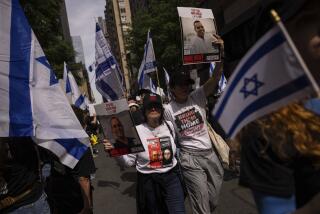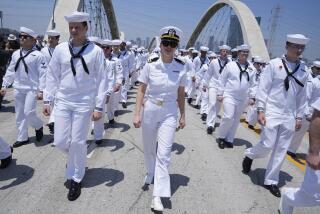Patriotism Abounds in N.Y. Harbor Parade
NEW YORK — A huge armada of tall ships sailed out of the pages of history into New York’s harbor Tuesday, symbolizing the eternal romance of the sea while paying tribute to America’s maritime heritage.
Imposing gray, electronically crammed dreadnoughts of the present anchored near the Statue of Liberty and saluted the graceful wooden vessels, which arrived with flags unfurled and sailors standing at attention on their masts.
President Clinton presided over what organizers labeled the largest-ever peacetime gathering of sailing and military vessels.
Thousands of pleasure boats cruised the harbor, while along the banks of the Hudson River spectators watched and cheered. Many brought picnics and stayed until dark to enjoy an immense fireworks display.
It was a red, white and blue Fourth of July celebration as American as apple pie--but with a mighty maritime topping.
One by one, the great sailing ships emerged from the morning mist into colored water sprayed from fireboats as the president and 5,000 invited guests watched from the 4.5-acre flight deck of the aircraft carrier John F. Kennedy.
For many on shore, the biggest surprise came suddenly when a B-2 stealth bomber flew over the fleet--punctuating the dichotomy between past and present.
“It looks like a bat,” said a woman obviously startled to see the strange-looking plane appear just above the tree line.
“I try to visualize back in 1609 when Henry Hudson first came up the river and there were Indians looking at these vessels, what they must have thought at the time,” said Charles Schwartz of New York City.
“It’s a beautiful sight. I was in the service in World War II, in the infantry. This makes me feel very patriotic and brings back a lot of memories.”
With the Statue of Liberty and Ellis Island serving as backdrops, Clinton also touched on patriotism.
“Staring out over the very waters where we sit today, Gen. George Washington saw the British warships landing in Staten Island, the vanguard of the largest expeditionary force ever launched by the British empire,” he said.
“As the armies eyed each other across the channel, the Declaration of Independence arrived from Philadelphia. George Washington ordered it to be read to the troops,” Clinton continued.
“It was at the tip of Manhattan Island just to our north where the troops first heard they were actually citizens of a new nation,” he said.
The president urged America to remain a bastion of opportunity.
“Perhaps more than any other nation in all history, we have drawn our strength and spirit from people from other lands,” he added. “. . . that is why on this Fourth of July, standing in the shadow of Lady Liberty, we must resolve never to close the golden door behind us.”
The day began with the president, his wife, Hillary Rodham Clinton, and their daughter, Chelsea, on board the cruiser Hue City, a guided-missile ship, reviewing 27 warships from 14 countries in only the sixth international naval review in history. The first review took place in 1893.
As the cruiser trooped the line, the president received salutes from the assembled warships. In a ceremony, repeated aboard the Kennedy, he administered the oath of reenlistment to crew members.
At the end of the review, the president received a 21-gun salute.
On board the carrier, he watched 20 people become U.S. citizens and joined them in the Pledge of Allegiance.
Clinton was introduced by Seaman Rosa Norales-Nunez, who entered the United States from Honduras seven years ago and who took the citizenship oath. She now serves on the carrier.
“This is my first hour as a United States citizen . . . and I am so proud to be an American,” she said.
The choice of the carrier was symbolic.
The nonprofit Operation Sail was established by President Kennedy in 1961 as a maritime vehicle to promote cultural exchanges, training and friendship among countries.
Among the guests on the carrier was JFK’s daughter, Caroline Kennedy Schlossberg, and her husband and children. Schlossberg christened the carrier in 1967 when she was 7.
In 1964, seven huge sailing ships participated in the first OpSail celebrating the World’s Fair in New York. Greater numbers of vessels returned for the bicentennial in 1976 and for the Statue of Liberty’s birthday celebration 10 years later.
Like previous celebrations, the tall ships were the stars of the day.
The 26 class-A sailing ships measuring over 160 feet long came from 19 countries. More than 100 smaller wind-powered vessels joined the parade.
All around them bobbed a Baedeker of boating: speedboats, sleek pointy-hulled cigarette boats, warships, houseboats, cabin cruisers, junks, tiny rowboats with outboard motors, tugboats, ferries, catamarans, rafts, cruise craft.
If it was built to float, it floated Tuesday in New York’s harbor.
But the numbers were somewhat smaller than expected. Before the parade, some officials predicted 70,000 craft would attend OpSail. The Coast Guard said, however, that a line of heavy squalls Monday night discouraged some boaters from coming, and it put the number of craft along the route at 30,000.
Onshore, there were empty spaces at some prime vantage points.
To keep order and protect the flotilla, the Coast Guard dispatched 33 cutters and 200 smaller vessels which were part of a massive security umbrella designed to thwart any attempt at terrorism. Helicopters patrolled the sky to ensure planes didn’t fly too close to the fleet.
On land and on sea, 28,000 New York City police officers and thousands more federal agents were on duty well into the night, until the fireworks show ended.
Clinton designated OpSail as a national security event, triggering a flood of federal resources.
As in previous events, the 295-foot, three-masted U.S. Coast Guard bark Eagle headed the parade of tall ships passing under the Verrazano Narrows Bridge into the harbor.
Sailing in the procession were a number of newcomers, most notably the 129-foot schooner Amistad, a replica of the slave ship made famous after its cargo of 53 Africans staged an uprising for freedom in 1839.
As some of the vessels passed the president aboard the carrier, crews in dress whites high in the rigging shouted greetings. Other sailors stood on deck and saluted. A few ships played show tunes over loudspeakers or tooted their horns.
“I think it just brings . . . New Yorkers and the world together,” said Andrew Stecklur of Putnam, N.Y., as he watched from shore. “We’re seeing something that’s part of history.”
*
Times researcher Lynette Ferdinand contributed to this story.
* CELEBRATING FREEDOM
Americans commemorate independence with parades, picnics and the oath of citizenship. A5
* LOCAL OBSERVANCES: B1
More to Read
Sign up for Essential California
The most important California stories and recommendations in your inbox every morning.
You may occasionally receive promotional content from the Los Angeles Times.










